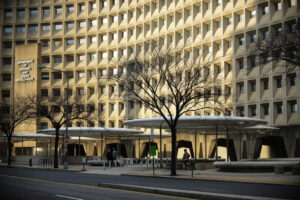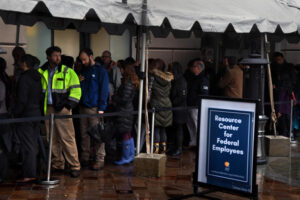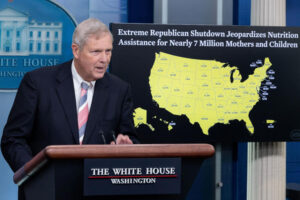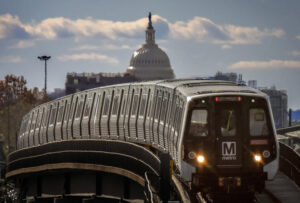SEPTEMBER 28, 2023

Washington region, brace for impact. The federal government is poised to grind to a halt on Oct. 1, after hard-right Republicans in the House indicated they would block any short-term funding solution that the House majority would come up with to keep the government open.
Perhaps nowhere in the country would the effects of a shutdown be felt as closely as the D.C. region, where the federal agencies, museums and other programs that make up the heart of Washington would run out of operating funds and begin to close.
Here’s how a government shutdown would affect D.C., Maryland and Virginia.
1. What impacts will we see in D.C.?
Municipal services: There would be no real impact on city services — ever since then-Mayor Vincent C. Gray (now D-Ward 7) and the D.C. Council plotted to defy the 2013 government shutdown by declaring all D.C. employees essential, and thanks to a provision in the federal appropriations bill for D.C., the city no longer has to pause nearly all aspects of its daily life during a shutdown. That said, for the love birds who just can’t wait, at Mayor Muriel E. Bowser’s request, Council member Christina Henderson (I-At large) is planning to introduce legislation that would allow the mayor to temporarily issue marriage licenses, which the council will consider at its Tuesday meeting.
Mail delivery will continue, as the Postal Service does not rely on Congress for funding of that service.
Courts: A spokesman for the D.C. court system had one big message for D.C. residents: If you receive a jury summons, yes, you must show up, because courts are open in the event of a shutdown. Trials, hearings and court services — including monitoring people on probation, pretrial release or court supervision — would continue, though with limited staff. The only court service that wouldn’t be available is marriage. The court’s child-care center would also not be open, and other day-care centers for federal workers would also be likely to close. Rep. Gerald E. Connolly (D-Va.) rang the alarm about the burden this could create for essential federal employees and has asked federal budget leaders to consider keeping the day-care centers operational.
Smithsonian museums and the National Zoo: As The Washington Post’s Fritz Hahn reports, the Smithsonian museums and the zoo would use prior-year funding to remain open as long as they can, after which they would shut down all activities that are federally funded. Memorials on the National Mall probably would stay open, but it’s unclear at the moment. Private museums in D.C. are not affected by the shutdown.

During the 2019 federal shutdown, World Central Kitchen set up a pop-up distribution center in a closed restaurant space next to the U.S. Navy Memorial to help federal workers.
2. What impacts will we see in Maryland?
Like the rest of the region, a large number of federal employees and service members call Maryland home.
More than 138,900 civilian federal workers and roughly 50,000 active-duty and reserve service members living in the state could go without paychecks during a shutdown, said Rep. Jamie Raskin (D-Md.). State officials said federal paychecks support 240,000 Maryland households, according to state income tax data, because many residents live in Maryland but commute to jobs in D.C. or Northern Virginia. That many Marylanders losing income — even for a short time — would disrupt the economy.
Maryland state officials plan to blunt the immediate impact of a shutdown by paying out federal benefits with state cash — for up to several weeks, and provided that the federal government assures states they’ll be reimbursed.
The state will commit up to $1 billion of its $5 billion in liquid cash to cover any dried-up federal funding stream, senior officials in the administration of Gov. Wes Moore (D) told reporters Thursday morning. That cash would cover an array of federal benefits, including support for the roughly 670,000 people who receive food aid through SNAP and the 56,000 who rely on the TANF cash-assistance program, officials said.
Montgomery County Executive Marc Elrich (D) said federal workers who end up furloughed can apply for unemployment benefits during that time, but they will have to pay the money back if and when they receive back pay from the federal government. The county executive also said he would be surprised if those workers could get unemployment checks to replace their missed paychecks right away. Unemployment payments would also only be a portion of a worker’s normal salary, which could leave families struggling to make ends meet.
“There are families, even at the federal employee level, who live paycheck to paycheck,” Elrich said.
Raskin said many paused federal programs could end up affecting Marylanders. Federal agencies would probably be slow to process new applications for social security payments and veterans benefits, though people already enrolled in those programs will continue to receive their checks. The National Institutes of Health would not be able to enroll new participants in clinical trials, said Raskin, who recently underwent treatment for cancer.
“Those clinical trials, for a lot of people, are a matter of life and death,” he said.
Travelers could also see delays at Baltimore-Washington International Marshall Airport and other Maryland airports. Although air traffic controllers and Transportation Security Administration agents are considered essential federal employees and expected to continue working without pay during a shutdown, in the past some of those workers have chosen not to show up for unpaid shifts. Staffing shortages could lead to slow security lines and flight delays, Raskin said.
3. What impacts will we see in Virginia?

The Capital Area Food Bank passes out canned goods and produce to federal workers outside a Giant grocery store in Alexandria, during the government shutdown in 2019.
A government shutdown would be a double whammy for Virginia, a state that’s home to more federal civilian employees and active-duty military personnel than almost any other.
Virginia boasts the second-largest number of federal civilian employees — 140,000 — behind only California. The commonwealth also has more than 156,000 active-duty and reserve members of the military — behind only California and Texas, according to a ranking by Governing Magazine. “Nonessential” federal workers would be furloughed, while “essential” ones and members of the military would remain on the job but without pay until after the shutdown. All those missed paychecks could take a toll on the state’s economy, especially in areas where those workers are concentrated. About 150,000 of the 1.6 million people who live in the Hampton Roads region, for instance, are active-duty or civilian military personnel, with another 40,000 privately employed in the defense industry, the Hampton Roads Chamber says on its website.
Virginia’s 22 national parks — ranging from battlefields and Historic Jamestowne to mountain trails and the Blue Ridge Parkway — also could take a hit. In some earlier shutdowns, the National Park Service allowed outdoor attractions to remain open but suspended maintenance, including restroom cleaning and trash collection.
4. What other programs will be affected?

Secretary of Agriculture Tom Vilsack speaks at a news conference on Monday about the impact of a government shutdown on federal nutrition programs.
One federally funded program that could be immediately affected locally by a shutdown is the Special Supplemental Nutrition Program for Women, Infants and Children, known as WIC.
Serving 7 million people nationally — including more than half of all the country’s newborns — the program’s funding would immediately stop flowing to the states, the White House said Monday.
“Women and children who count on WIC would soon start being turned away at grocery store counters, with a federal contingency fund drying up after just a few days and many states left with limited WIC funds to operate the program,” the White House said.
An Agriculture Department contingency fund may keep WIC funded for a day or two, Agriculture Secretary Tom Vilsack said Monday at a press briefing. After that, states will be forced to tap unspent WIC money to keep the program going.
In Fairfax County, about 15,490 people are receiving WIC assistance through federal funding that is administered through the Virginia Health Department, according to Lucy H. Caldwell, director of communications for the Fairfax County Health Department.
“In the event of a potential government shutdown, we are informed that the Virginia WIC program will operate for at least six to eight weeks following Oct. 1,” Caldwell said.
In D.C., where nearly 14,000 residents are served by WIC, D.C. Health said program recipients are encouraged “to contact their local WIC office for a WIC appointment” to determine next steps if the benefits lapse because of a shutdown.
“D.C. Health is working closely with our federal partners to determine possible next steps in the event of a government shutdown,” D.C. Health said in a statement.
The most pressing concern for Maryland officials is the nearly 125,000 state residents enrolled in WIC. Those families could go hungry if the program runs out of money during a shutdown. In Montgomery County alone, more than 16,000 children and 13,000 women rely on the program.
“A shutdown will greatly affect the WIC program and as part of our planning, we are working to identify options to mitigate any adverse impacts,” said Chase Cook, a spokesman for the Maryland Health Department, which administers the WIC program.
Montgomery County officials said they are looking at ways to mobilize existing food resiliency programs, food pantries and soup kitchens to provide meals for people who may lose WIC benefits next month.
5. Will there be any impact on Metro?

A Metro train rounds a corner in Northeast Washington.
Randy Clarke, Metro’s general manager, said the main impact of a government shutdown for the transit agency would likely be fewer passengers — and for a transit agency already struggling to close a $750 million shortfall in next year’s budget, the timing couldn’t be worse. Metro recently increased rail service to historic highs in hopes of luring more people back.
“There’s no question that this is not a good thing for the country, but it’s certainly not a good thing for Metro specifically,” Clarke said. “And the timing is really challenging because ridership is really starting to grow back. So, you know, we’re going to be watching this very closely and we’re hoping that if it happens, it’s very short.”

































































































